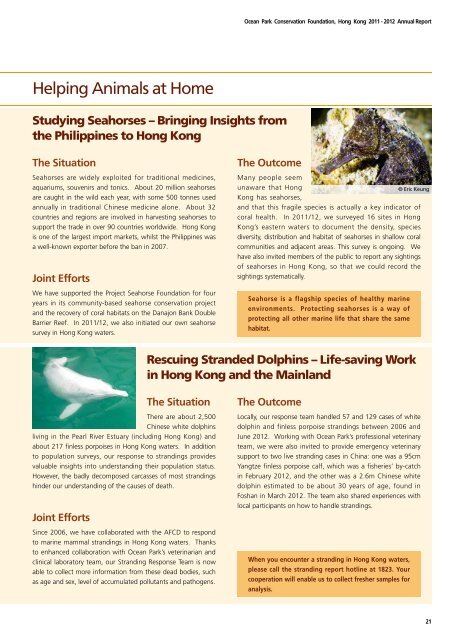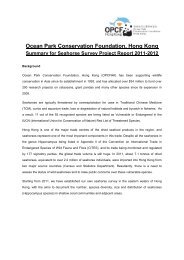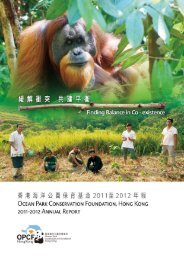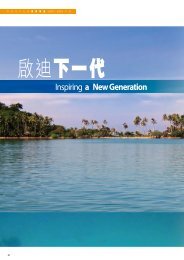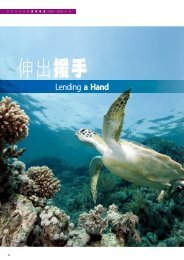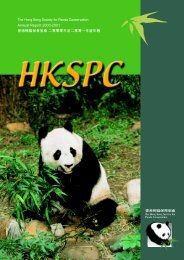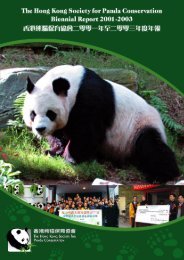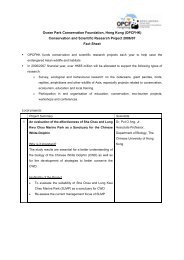å®æ´æ件ç覽 - é¦æ¸¯æµ·æ´å ¬åä¿è²åºé
å®æ´æ件ç覽 - é¦æ¸¯æµ·æ´å ¬åä¿è²åºé
å®æ´æ件ç覽 - é¦æ¸¯æµ·æ´å ¬åä¿è²åºé
You also want an ePaper? Increase the reach of your titles
YUMPU automatically turns print PDFs into web optimized ePapers that Google loves.
Ocean Park Conservation Foundation, Hong Kong 2011 - 2012 Annual Report<br />
Helping Animals at Home<br />
Studying Seahorses – Bringing Insights from<br />
the Philippines to Hong Kong<br />
The Situation<br />
Seahorses are widely exploited for traditional medicines,<br />
aquariums, souvenirs and tonics. About 20 million seahorses<br />
are caught in the wild each year, with some 500 tonnes used<br />
annually in traditional Chinese medicine alone. About 32<br />
countries and regions are involved in harvesting seahorses to<br />
support the trade in over 90 countries worldwide. Hong Kong<br />
is one of the largest import markets, whilst the Philippines was<br />
a well-known exporter before the ban in 2007.<br />
Joint Efforts<br />
We have supported the Project Seahorse Foundation for four<br />
years in its community-based seahorse conservation project<br />
and the recovery of coral habitats on the Danajon Bank Double<br />
Barrier Reef. In 2011/12, we also initiated our own seahorse<br />
survey in Hong Kong waters.<br />
The Outcome<br />
Many people seem<br />
unaware that Hong<br />
Kong has seahorses,<br />
and that this fragile species is actually a key indicator of<br />
coral health. In 2011/12, we surveyed 16 sites in Hong<br />
Kong’s eastern waters to document the density, species<br />
diversity, distribution and habitat of seahorses in shallow coral<br />
communities and adjacent areas. This survey is ongoing. We<br />
have also invited members of the public to report any sightings<br />
of seahorses in Hong Kong, so that we could record the<br />
sightings systematically.<br />
Seahorse is a flagship species of healthy marine<br />
environments. Protecting seahorses is a way of<br />
protecting all other marine life that share the same<br />
habitat.<br />
Rescuing Stranded Dolphins – Life-saving Work<br />
in Hong Kong and the Mainland<br />
The Situation<br />
There are about 2,500<br />
Chinese white dolphins<br />
living in the Pearl River Estuary (including Hong Kong) and<br />
about 217 finless porpoises in Hong Kong waters. In addition<br />
to population surveys, our response to strandings provides<br />
valuable insights into understanding their population status.<br />
However, the badly decomposed carcasses of most strandings<br />
hinder our understanding of the causes of death.<br />
Joint Efforts<br />
Since 2006, we have collaborated with the AFCD to respond<br />
to marine mammal strandings in Hong Kong waters. Thanks<br />
to enhanced collaboration with Ocean Park’s veterinarian and<br />
clinical laboratory team, our Stranding Response Team is now<br />
able to collect more information from these dead bodies, such<br />
as age and sex, level of accumulated pollutants and pathogens.<br />
The Outcome<br />
Locally, our response team handled 57 and 129 cases of white<br />
dolphin and finless porpoise strandings between 2006 and<br />
June 2012. Working with Ocean Park’s professional veterinary<br />
team, we were also invited to provide emergency veterinary<br />
support to two live stranding cases in China: one was a 95cm<br />
Yangtze finless porpoise calf, which was a fisheries’ by-catch<br />
in February 2012, and the other was a 2.6m Chinese white<br />
dolphin estimated to be about 30 years of age, found in<br />
Foshan in March 2012. The team also shared experiences with<br />
local participants on how to handle strandings.<br />
When you encounter a stranding in Hong Kong waters,<br />
please call the stranding report hotline at 1823. Your<br />
cooperation will enable us to collect fresher samples for<br />
analysis.<br />
21


